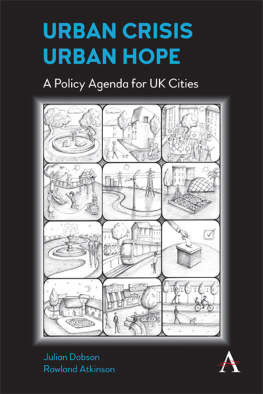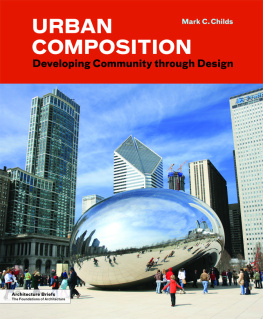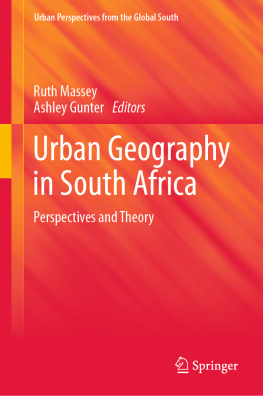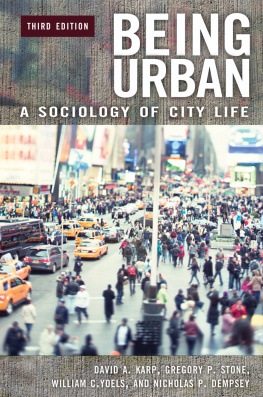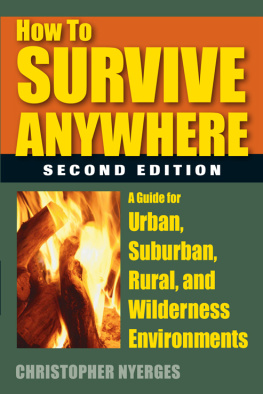CAN SMALL URBAN COMMUNITIES SURVIVE?
To Andrej and Tadej
Can Small Urban Communities Survive?
Culturological analysis in urban rehabilitation: cases in Slovenia and Scotland
Branka Berce-Bratko
First published 2001 by Ashgate Publishing
Reissued 2018 by Routledge
2 Park Square, Milton Park, Abingdon, Oxon OX14 4RN
711 Third Avenue, New York, NY 10017, USA
Routledge is an imprint of the Taylor & Francis Group, an informa business
Copyright Branka Berce-Bratko 2001
All rights reserved. No part of this book may be reprinted or reproduced or utilised in any form or by any electronic, mechanical, or other means, now known or hereafter invented, including photocopying and recording, or in any information storage or retrieval system, without permission in writing from the publishers.
Notice:
Product or corporate names may be trademarks or registered trademarks, and are used only for identification and explanation without intent to infringe.
Publisher's Note
The publisher has gone to great lengths to ensure the quality of this reprint but points out that some imperfections in the original copies may be apparent.
Disclaimer
The publisher has made every effort to trace copyright holders and welcomes correspondence from those they have been unable to contact.
A Library of Congress record exists under LC control number: 2001270343
ISBN 13: 978-1-138-73470-8 (hbk)
ISBN 13: 978-1-315-18709-9 (ebk)
- AESOP Association of European Schools of Planning
- ARGE Agricultural Group for Europe
- CA Culturological Analysis
- CBA Cost Benefit Analyses
- DC District Council
- DOE Departement of Environment
- EDRA Environmental Design Research Association
- EDZ Ethnologically Defined Zones
- EEC European Economic Community
- EIA Environmental Impact Assessment
- EISs Environmental Impact Statements
- ENHR European Network of Housing Research
- ESDP European Spatial Development perspective
- GDC Glasgow District Council
- GEAR Glasgow Eastern Area Renewal
- GGBH Greater Glasgow Health Board
- HA Housing Association
- HAA Housing Action Area
- HAAI Housing Action Area Improvement
- HC Housing Corporation
- HMSO Her Majesties Stationary Office
- LP Local Plan
- LPA Local Plan Area
- MSC Manpower Services Commission
- NEPA National Environmental Policy Act
- NTS National Trust for Scotland
- OCP Office for Conservation and Protection
- OECD Organisation for Economic Cooperation and Development
- PA Project Area
- RTPI Royal Town Planning Institute
- SDA Scottish Development Agency
- SEAM Social and Economic Assessment Model
- SH Scottish Homes
- SIA Social Impact Assessment
- SO Scottish Office
- SRC Strathclyde Regional Council
- SSHA Scottish Special Housing Association
- TAT Transcendental Assessment Test
- TIA Territorial Ipact Assessment
- UISRS Urban Planning Institute of the Republic of Slovenia
- UNEP United Nations Environmental Programme
- WWI World War One
- WWII World War Two
I am very grateful for excellent advice and support given by Professor Urlan A. Wannop as my Supervisor during the preparation of the thesis from which the present text has been prepared. I also wish to thank for the academic dialogue provided by Janet Brand, Dr. Peter Green and Anthony Ramsay, with special thanks to the last-named for constant advice and encouragement in the Centre for Planning. Many thanks to Professors: Andrej Poganik, Peter Fister and Vladimir Braco Musi from the Faculty for Architecture in Ljubljana, Professors Dieter Frick from Berlin, Jozef Niznik from Warszawa, Peter Nas from the Group of Urban Anthropology in Leiden. Margaret Dunn and Adrian Green in the Centre for Planning, Professor Ian Buchanan in the Computer Science Department University of Strathclyde, Professor Donald Michie, Dr.Tim Niblett from The Turing Institute have also helped in various ways. The Directors of the Town Planning Institute of Slovenia have been generous in sanctioning study leave, and the Slovenian Ministry of Science and Technology in providing scholarships. Their support has been much appreciated. Colleagues in the Institute have cooperated in various ways, especially Lenka Molek and Kaliopa Dimitrovska. I offer them my sincere thanks.
The work could not have been accomplished without the help of all those who agreed to be inteviewed. I give them all my fullest thanks. Personal friends in Glasgow have helped in practical ways as well as by providing emotional support - particular mention must be made of Marjorie Byrne and her family and friends, and of Mary McGilvaray, John Kraska and Jimmy Byrne.
I would like to express my deep gratitude to the International Centre for Comparative Research (ICCR) in Vienna, especially to Directors Ronald Pohoriles and Liana Giorgi for putting forward this text for publication. I would also like to thank Ashgate publishing house for their kind cooperation and forbearance during the finalisation of this text, and particularly to Anne Keirby, Desk Editor Rachel Hedges and to Editorial Manager Ann Newell. In the preparation of the text locally, I thank profusely Miklav Mui and Rupert Gole for illustrations and the preparation of the text for the publication, Minister Pavle Gantar for academic suggestions, and Zvezda Koelj for proofreading. I am also deeply appreciative of the patience and tolerance of my sons Andrej and Tadej, my husband Ivan, my mother Ana, and my parents-in-law Angela and Ivan Bratko.
The text founds largely on a doctoral thesis Culturological Analysis in Urban Rehabilitation: Cases in Slovenia and Scotland prepared at the University of Strathclyde in Glasgow for which I was awarded a PhD in Urban & Regional Planning; and represents an extension of earlier work produced during my doctoral studies at the University of Ljubljana. The quantitative part was done during my first doctoral study and the more qualitative ones were done in my Scottish thesis. Ideas for the thesis stemed from almost twenty years of planning research carried out at the Urban Planning Institute in Ljubljana. I was also involved in Edinburgh, Scotland, since 1979 than in the Department of Urban and Regional Planning, headed by the late Professor Percy Johnson Marshall at the University of Edinburgh, and much later at Harriot-Watt University. During this period there was involvement also in Glasgow, since 1986 at the Department of Urban and Regional Planning as visiting part time lecturer under Prof. Urlan Wannop and later as doctoral student until 1993 at the Centre for Planning in Glasgow. Presently occupied in the Research Departement of the Parliament of the Slovenian Republic.
Comparison between Slovenia and Scotland was possible because of my living for some time in both countries and similar statistics, particularly percentage of council housing in 1990 in Scotland was 56% and in Slovenia 57%. Slovenia as the northern part of former Yugoslavia and Scotland the North of UK.
Council housing was especially important in Scotland because a higher proportion of the population in England could not themselves afford to buy a house of modern standards. The legislation on municipal housing from 1920s onwards did not provide adequately for the financing of proper maintenance of the building fabric. Often the locations chosen for such workplaces were not suitable - in other words, the approach was too compartemented and did not assess the needs of the population to be re-housed in a holistic way, i.e. did not evaluate or anticipate all or even most of the day-to-day needs and interests of the population to be accomodated there.




